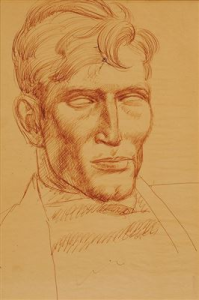
Biography
Julius Woeltz was born in San Antonio, TX in 1911. He attended public schools in San Antonio, taking private lessons in music and art. He studied with the portrait painter Wilson K. Nixon, the muralist José Arpa and Arpa's nephew Xavier Gonzales. In high school he was selected by the city's art supervisor to attend Saturday classes led by Xavier Gonzalez at the Witte Museum. Gonzalez was not much older than Woeltz, and they became close friends and colleagues.
Upon graduation Woeltz attended the Academie Julian in Paris and the Art Institute in Chicago. Returning to San Antonio, he taught select public school students much as he himself had initially been taught. He and Gonzalez traveled together to Mexico to study the work of Diego Rivera. Woeltz also taught at the Witte Museum.
In 1932 Woeltz was named art director at Sul Ross State Teachers College in Alpine, TX. He started a Summer Art Colony, which was to run for nearly 20 years, and hired Xavier Gonzalez as an instructor. He remained in Alpine for four years, completing a number of murals depicting the Big Bend area. He took his students on outings for plein air painting, and regularly spent time in Mexico. His work, not surprisingly, showed the influence of Diego Rivera and Jose Clemente Orozco.
In 1936 Woeltz moved to New Orleans, where Gonzalez had preceded him to take a teaching job at Sophie Newcomb College (the coordinate women's college of Tulane University). For four years Woeltz taught at the New Orleans Art School, after which he joined the faculty of the University of Texas in Austin. He remained there for ten years, except for a leave of absence during World War II when he served in the Army Air Corps, stationed in San Antonio. He died young, in 1956.

Critical Analysis
Woeltz was a prolific muralist, completing about 30 murals during his short career. In style he had the panache of Orozco, but with a brighter palette, attuned to the look of the Texas landscape. This may reflect his interest in plein air painting and a desire to infuse this type of sensibility into the art of his students. His work has been described as Cubist, which suggests elements of a machine-like nature. Indeed, if one looks at his Armarillo murals, one sees in "Gang Plow" an explicitly rendered agricultural machine. To the left of the machine there is a wheat field, its stubble rendered in a slightly stylized manner with a very soft natural palette. But to the right of the machine - as if transformed by it - there is a series of plowed furrows, which look more geometric than soil-like and are presented with a strikingly colorful other-worldly palette. The geometric motif is carried further in "Disk Harrow," which hangs to the right of "Gang Plow." But here the machine is at home in its geometric element. One can almost see the naturalistic scene on the left transformed by the machine into the rigid abstraction of nature shown on the right. So, in these paintings one sees a transformation from purely representational art to purely abstract art.
While this interpretation may be reading a bit too much into Woeltz's intent, it perhaps captures the sort of excitement that one feels in looking at these paintings. There is more going on than just a tractor working its way through a field. The tractor is creating something of a monument, and hence the painting itself stands as something of a monument.
Murals
- Benton, Arkansas - Saline County Courthouse: The Bauxite Mines
- Amarillo, Texas - J. Marvin Jones Federal Building: Cattle Branding
- Amarillo, Texas - J. Marvin Jones Federal Building: Cattle Loading
- Amarillo, Texas - J. Marvin Jones Federal Building: Coronado's Exploration Party
- Amarillo, Texas - J. Marvin Jones Federal Building: Disk Harrow
- Amarillo, Texas - J. Marvin Jones Federal Building: Gang Plow
- Amarillo, Texas - J. Marvin Jones Federal Building: Oil
- Elgin, Texas - Post Office: Texas Farm
References
- Alpine's Kokernot Lodge, Texas Mountain Trail September 09 (2011).
- Julius Edwin Woeltz (askART).
- Julius Edwin Woeltz (Am. 1911-1956) (David Dike Fine Art).
- Julius Woeltz (Wikipedia).
- Julius Woeltz at David Dike Fine Art Auction, Urban Art & Antiques January 24 (2014).
- Marfa Mondays 3: Mary Bones on the Lost Art Colony (C.M. Mayo's Book Notes and Convos).
- A Mural Renaissance in West Texas, Texas CEO Magazine May 14 (2021).
- Matt Joyce, The Museum of the Big Bend Gets a Gorgeous $11 Million Expansion, Texas Monthly June 27 (2023).
- Leslie Thompson, Texas Post Office Murals, Part II: West Texas, Glasstire February 19 (2023).